Global

“Ancient Beirut lies buried beneath the port area, making excavations impossible.” This massive explosion has dug deep craters into the land. (image: Internet)
I sat upright tensed as I viewed the unfolding headlines with horror and disbelief. This was the night of 4th August 2020 as every news channel carried the news of the deadly explosion at the Beirut port in Lebanon. Its impact shook the Mediterannean island of Cyprus; 234 kms. away. This calamity comes in the wake of a long conflict-ridden trail of crisis to crisis: political partisanship, power blocs with own agendas, economic meltdown, severe recession, rampant corruption, public protests and COVID-19 - to a nation already on its knees - and now yet another man-made debacle that has brought colossal devastation and flattened a people, a city, a country. For all of six long years; in an incredible act of inertia - outright laissez-faire - some 2750 tonnes of ammonium nitrate remained stored at the Beirut port. A man-made menace long waiting to be released; and on 4th August the powder keg exploded. Located in central Beirut, a densely populated environs; the appalling desolation of the city's commercial lifeline is beyond belief. Declared fatality and injury figures are only tips of the icebergs. In its shock-wave aftermath; people remain homeless and many missing. Food insecurity will be the result of the haunting images of devastated wheat silos. Medical supplies were already in shortage due to economic constraints and hospital resources stretched as a result of pandemic ravages. Half of Beirut's infrastructure is in ruins. Modern buildings as well as civil war affected relics have collapsed or appear imminently to collapse. A web of rubble in the carnage reveals demolished homes, roofless remains, cracked columns and plaster and glass shrapnel everywhere. Matchbox-like cars appear thrown away here and there. Reeling from the blast, Beirut lies broken.
Early harrowing images of skeleton buildings within the port area shrouded in grey smoke and floating toxic clouds reminded me instantly of photographs of the aftermath of Hiroshima and Nagasaki nuclear bombings by the United States. Little did I know that today, the 6th of August 2020 is the 75th anniversary of the Hiroshima apocalypse; where generational fallout still impacts, close to a century later. I watch on-going reporting and visuals of this unique city and country with an ache in my heart and tears in my eyes.
'Beirut: Jewel of the Middle East' is the title of the chapter in my book 'Fragrance of the Past: A Middle Eastern Itinerary' (2007). In the backdrop of this far-reaching catalysmic event; I want to provide a personal contextual setting to a Lebanon and a Beirut that was home to me in the late 1960s; "its golden halycon years" before the Lebanese civil war that "seared the country from 1975 to 1991...For those of us who knew Lebanon and Beirut in its Golden Age, a sweeping feeling of loss and sadness overcomes one." Beirut was known as 'Paris of the East.' Beirut then was a destination for rest, recreation and retail therapy. Equivalent to where today we rank Bangkok, Dubai and Singapore. Medical treatment at the American University Hospital (AUH) where I did volunteer work on Saturday mornings pushing the trolley for 11am coffee treats; remains one of the top medical institutions in Lebanon (renamed AUB Medical Center). A Disaster Response Foundation Fund was established for COVID-19 and then came the Beirut blast.
The American University of Beirut (AUB), established in 1866 where I received my MA in Sociology in 1973 remains a landmark in the region and beyond. Virtually any American university scholarship provided 'east of the Suez' at the time was allocated to AUB. "Until the mid-1970s, AUB was a pivot and a beacon of academia in the Middle East...In 1948, at the first meeting of the United Nations convened in San Francisco, there were more graduates of AUB among the participants than any other single university, some nineteen in all." My alma mater was ranked the top university in the Arab region in the 2018 QS World University Ranking index. Current AUB President Fadio Khuri had to face its biggest challenge in 154 years of existence due to combined factors confronting the country and its latest hit the COVID-19 pandemic. In June 2020, 25% layoffs, salary cuts and administration departments' closure were put in force. In a telling comment from an AUB graduate, he declared: "It's a very bitter cup to drink, but we don't get to choose our battles in life and unfortunately this is the one that I've inherited." The Beirut blast was yet to unfold.
"Ancient Beirut lies buried beneath the port area, making excavations impossible." That is no longer the case. This massive explosion has dug deep craters into the land. "The ancient name for Beirut was Biruta - a Semitic word for 'wells.' In 2020, we have its equivalent and more. For the punctured coastline has absorbed Mediterranean waters. Who has not passed through and stayed on in this strategic and fertile strip of Phoenicia until ousted by more powerful forces? "Lebanon has historically been at the crossroads of culture, at the confluence of Islam and Christianity and Arab and Western civilisations." Lebanon acquired independence from the French in 1946. Persians, Greeks, Romans, Arabs, Christian Crusaders, the Ayyubids, the Ottomans and the French have all occupied and influenced the land. It is significant that within forty-eight hours, President Emmanuel Macron of France paid a day's visit to Beirut. In an extraordinary move, over 55,000 signed an online petition for France, the former colonial occupier to take control of Lebanon; reports Deutsche Welle, the German media agency on 7th August. Such is the level of despair. The country was under a French mandate from 1920 to 1945.
In a tight knit system built over close to a century now, innumerable analysts have put forth their individual assessment of the deep chasms in Lebanon's political profile. According to Kamal Salibi in 'A House of Many Mansions: The History of Lebanon Reconsidered' (1988), 'To create a country is one thing; to create a nationality is another.' In 'Murder, Mayhem, Pillage and Plunder: The History of the Lebanon in the 18th and 19th Centuries' authored by Mikhayil Mishaqa in Arabic and translated into English by Wheeler M. Thackston Jr. (1988); we take note: "In the small, pluralistic society of the Lebanon, localism, kinship and clan loyalties were the primary societal bonds. Confessional adherence to the sect into which one was born was inevitable, for no one could exist without such a tie, but religious affiliation appears to have been of less importance overall and certainly less a factor than liege loyalty." Thomas L. Friedman in 'From Beirut to Jerusalem' (1989) assesses the civil war (1975-1991): 'But how could a city go from being a vision of heaven to a vision of hell practically overnight? Because it was too good to be true, because Beirut in its heyday was a city with a false bottom.' Dr. Khouri, President of AUB at an interview in June 2020, stated: "The poison in the American constitution was slavery. The poison in the Lebanese constitution is sectarianism." In summary of the immensely complex strains of affiliation; "It was the beloved national poet Khalil Gibran who wrote, in 1934 in 'The Garden of the Prophet', 'Pity the nation divided into fragments, each fragment deeming itself a nation.' His words are sadly prophetic."
"I returned to Beirut in 1978. I cried when I saw the city. Entire blocks were black skeleton buildings. Just as on television when they show wartime Berlin, you could see through some of the buildings. Jagged and torn iron rods hung between floors. The pavement of the famed Corniche Boulevard that hugs the coastline was home for thousands of refugees from the south. It was a shamble of slums. Before coming to Beirut, I knew there was a civil war going on but stupidly or wishfully took no notice of it. Reality hit me hard."
"After twenty-one years, I was once again on Middle East Airlines (MEA) now approaching Beirut on a flight from Tehran. In 1999...My level of sentimentality knew no bounds...I entered the campus, I looked above at the familiar AUB motto engraved on the wall. 'That they shall have life and have it more abundantly.' I gulped in emotion...I located the only remaining Professor from my time at AUB, Dr. Samir Khalaf...I met my Professor of Sociology after twenty-six years...he presented me with a signed copy of his book 'Beirut Reclaimed' (1993), with a Preface by the legendary Palestinian cultural critic Edward W. Said. With immense pride I was able to return the gesture by presenting him with a copy of my book 'Gender and Development' (1996) published by the American University in Cairo Press.The College Hall houses the main adminstrative offices and the office of the President of AUB. It was completed in 1873. A bomb blast destroyed College Hall during the civil war in 1991. A massive fund-raising among AUB alumni worldwide resulted in a new College Hall that was completed in 1999. Tragically, history repeats itself again and again. Online fundraising is ongoing today by the globally dispersed Lebanese diaspora - once again.
"A deeply moving, poignant and loving memoir to AUB and Beirut is Ann W. Kerr's book 'Come with Me from Lebanon (1994). "As a young American, she arrived at AUB in 1954 to pursue her studies. She met her husband Malcolm Kerr at AUB. He was the son of AUB professors. In 1981, Malcom was offered the post of the President of AUB. It was the pinnacle of his life's career and desire....Kerr was the first AUB graduate to become President of his alma mater. In the midst of the civil war, Malcolm Kerr was gunned down on his way to his office room at College Hall in 1984. He lies buried beside College Hall under a massive banyan tree that he used to climb while growing up on the AUB campus. A tablet notes: 'He lived abundantly.'"
Not far from 2020's bombed out Beirut port, stands the once iconic St. Georges Hotel. It opened for opulent business in 1920. "It was the watering hole for regional journalists and the rich and famous were to be found spending time on its famed terrace overlooking the blue Mediterranean. Now it stands forlorn, covered in canvas, as it awaits total reconstruction - a skeletal symbol of its past glory." That was in 1999. On 29th July 2020, the Lebanese government ordered its closure. After the civil war, it had never been restored. Such is the irony; another legend gone with the wind. And the Beirut blast was a week away. Flashback to 1999; bullet-scarred buildings like a bad case of measles are painful to see. Afflicted markings stand there without walls or roof. Tragic reminders of the urban warfare that tore the city apart. Beside state-of-the-art glass and chrome clad shopping malls, I spotted shattered buildings full of shattered lives." Is it Lebanon's fateful destiny to undergo such turbulence and trauma - again and again? Déjà vu?
My last visit to Beirut was in 2002. "In the heart of the symbolic resurgence, is a thriving café full of young Lebanese yuppies...At the edge of the terrace is a steep drop and on the land below rows of Roman antiquity columns stand majestically...Another glance reveals a three-storeyed building with no roof and few walls and with a tree growing on the third floor. These three structures coexist in a bizarre way as testimony to the civil war that is the hallmark of the twentieth century history of Lebanon. Everyone speaks of 'before the war' and 'after the war.'" A few decades later in the twenty-first century, all of Lebanon and the world will refer to 'before the explosion' and 'after the explosion.' Lebanon's turning points now have two historical timelines. How does one come to terms with 'the more it changes, the more it remains the same?' Similar feelings of loss had once overwhelmed a sixth century poet "Here am I, the wretched city, lying in ruins, my citizens dead....you who pass me by, bewail my fate and shed a tear in honour of Berythus, that is no more..." This heart-rending lament and plea remains ominously real today - fourteen hundred years later.
In my concluding paragraph in 'Beirut: Jewel of the Middle East', I write: "Phoenix (Greek) from which the name Phoenicia (the ancient name of the Lebanese territory) derives, was the term used for the date palm. It was also the name for the magnificent 'bird of Arabia' that as it aged, set itself on fire then reemerged in full youthful vigour from its own ashes..." We dream for this Phoenix to appear.
In acts of sympathy and solidarity, bold buildings all over the world have lit up their tall facades with the red and white coloured flag that features the national emblem - the majestic green cedar tree of Lebanon. Here is my humble yet heartfelt contribution from Bangladesh. For precious memories flood my soul.
Raana Haider is the author of 'Fragrance of the Past: A Middle Eastern Itinerary', Tara-India Research Press, New Delhi, 2007. All excerpts are sourced from this book.



















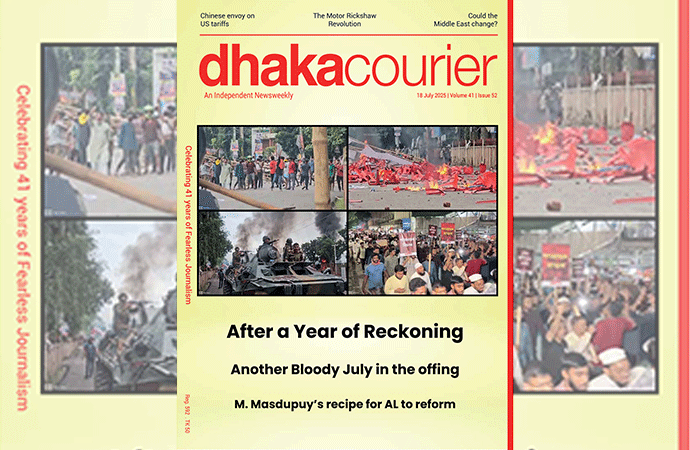
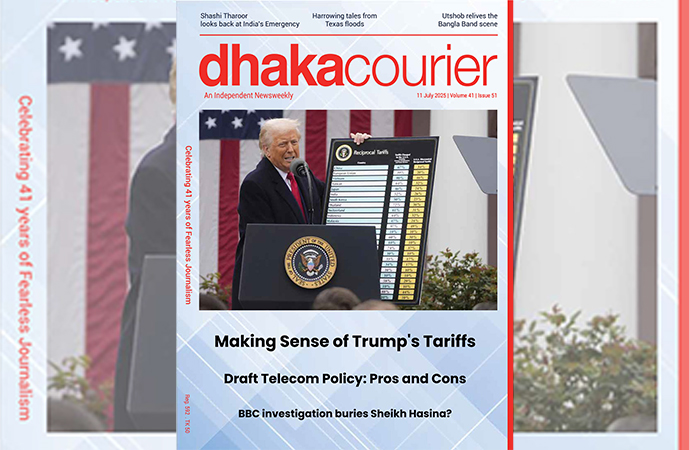
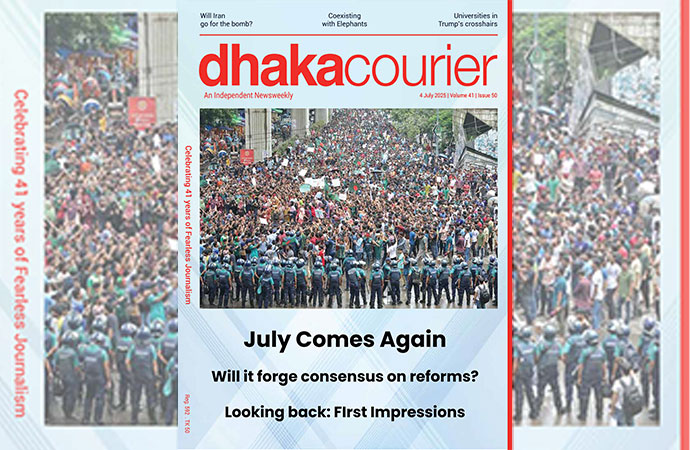
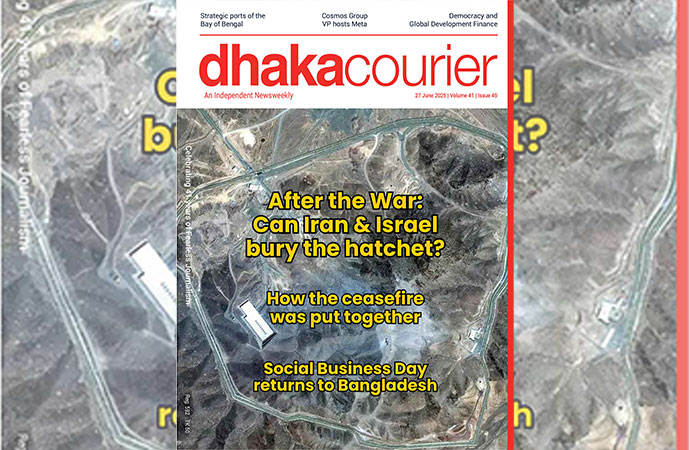
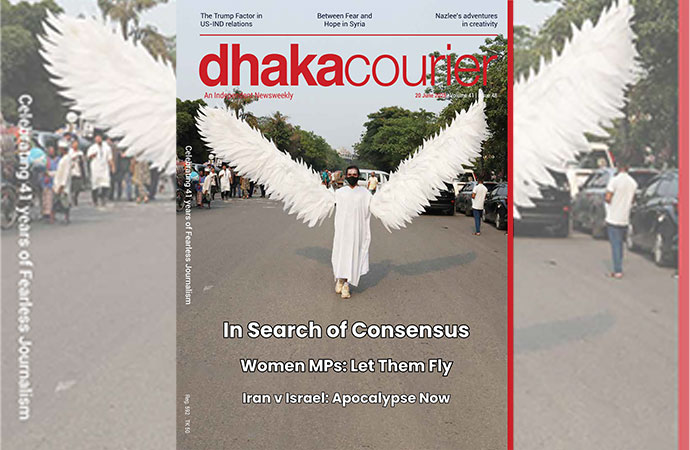

Leave a Comment
Recent Posts
The Northeastern Question
When secessionist movements sprang up across the Eastern European part ...
Trump’s Tariff: How far should ...
Will Bangladesh manage to get a last minute reprieve on its 'Trump tar ...
Rivers, Peaks, and Expressions – My Experience at th ..
What lies behind the alarming spike in violence agai ..
A Himalayan choice
Twenty Palestinians were killed at a food distributi ..